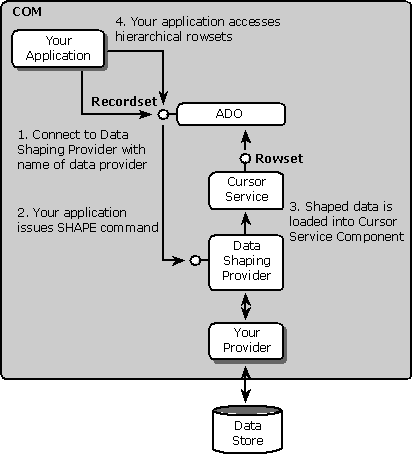
MDAC 2.5 SDK - OLE DB Providers
Data Shaping Service for OLE DB
OLE DB developers wanting to create rowset hierarchies can use the Data Shaping Service for OLE DB, also referred to as the Data Shaping Provider in this guide.
The Data Shaping Service for OLE DB allows an application to create relationships that had not previously existed between keys, fields, or rowsets. The provider supports the Shape language and any other command language supported by your data provider. The Shape language allows you to define rowset hierarchies built from rowset data obtained from a data provider. By connecting to the Data Shaping Service for OLE DB, you can execute various SHAPE commands to establish relationships between retrieved result sets and, if desired, group those new rowsets within a hierarchical structure.
You can also perform aggregations on newly formed hierarchical structures, summing at any level and even skipping levels if desired.
It is possible to add to existing hierarchies. The reshaping facility can be used to give an existing rowset a new parent rowset. The reshaping facility will not alter the existing rowsets or any hierarchical relationships that may exist between them.
Data can be kept current by using the ADO Resync and Requery methods or by defining the hierarchy as parameter-based.
The Data Shaping Provider uses the Cursor Service for OLE DB as its rowset implementation.

The following technical articles and white papers are posted on the "Technical Materials" page of the Universal Data Access Web site at http://www.microsoft.com/data/techmat.htm or are included with the Microsoft® Data Access Components (MDAC) SDK. Articles are listed here in order of their relevance.
Their presence and location are subject to change with each release. Other articles can be found in the Microsoft Developer Network (MSDN™) Library. Detailed articles concerning known limitations or workarounds can be found in the MSDN Knowledge Base.
| Documents | Date written/posted |
| OLE DB/ADO: Making Universal Data Access a Reality | Late 1998 |
References
ADO Programmer's Reference
Web sites